The best computer speakers 2024: top speakers for your PC
Pump up the jams with the best computer speakers

1. The list in brief
2. Best overall
3. Best budget PC speakers
4. Best for surround sound
5. Best with mind-blowing sub
6. Best for gamers on a budget
7. Best PC soundbar
8. Best for casual studio work
9. Best budget for creatives
10. Best Bluetooth PC speakers
11. Best for small spaces
12. How to choose
13. How we test
The best computer speakers must walk the line between great audio quality, good value, and of course how much desk space they take up. If you work or play games at a home desktop, we strongly recommend investing in a set of speakers for your PC - trust us, your neck will thank you.
While the best PC gaming headsets and the best headphones are great for your ear holes and can be invaluable for serious competitive gamers, it's better for your auditory health not to wear a chunky headset all day long. But the built-in speakers on your laptop or monitor are rarely adequate for anyone who really cares about audio, even on high-end products like the M3 MacBook Pro.
With that in mind, we're here to help. We've compiled a list of the very best speakers and sound systems for your PC, from affordable twin-speaker setups to beefy subwoofers and soundbars. We've tested dozens of computer speakers over the years and our team here at TechRadar includes multiple audio experts, so we can bring you the best recommendations for your needs and budget.
The quick list
There are a lot of options to choose from when it comes to the best computer speakers for your setup so we narrowed down your options. We've tested hundreds of PC speakers over the years and handpicked the best of the best 2023 has to offer. Take a look at our top picks below, and be sure to hit "Read more below" for a more informed decision.

Best computer speakers overall
A great-sounding set of speakers in an affordable package, these may be a little older, but it remains the best option for most people.

Best budget PC speakers
For a 2.1 PC speaker set that's under $50/£50, this produces great audio and does a great job of minimizing distortion at loud volumes.
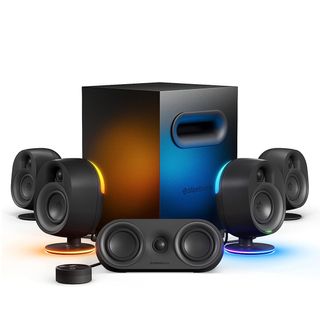
Best for true surround sound
With two front satellites, a center channel speaker, two rear satellites, and a subwoofer, this will take your audio to a deeper level.

Best with mind-blowing sub
Even better than its predecessor, this delivers crisp, detailed highs, full and present mids, and a whole lot of punchy bass and deep rumble.
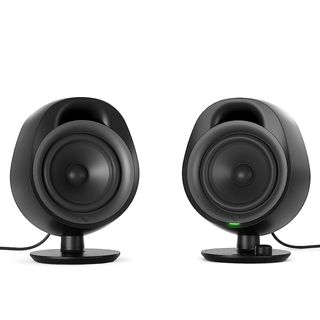
Best for gamers on a budget
Experience great quality audio and an immersive soundstage, as well as access to Steelseries’ audio suite, minus the steep price with this stereo option.
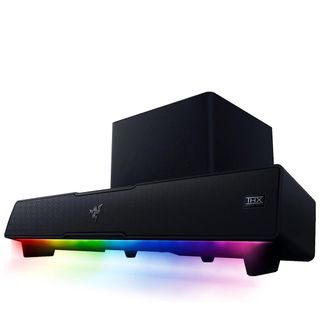
Best soundbar for PC
Want a 5.1 speaker system that's also space-saving? This feature-rich PC soundbar is just the ticket for a truly immersive experience.
Load the next 4 products...

Best for everyday and light studio work
Powerful and room-filling, these switch from HiFi-sounding to a flatter, more neutral frequency response that's ideal for doing studio work.
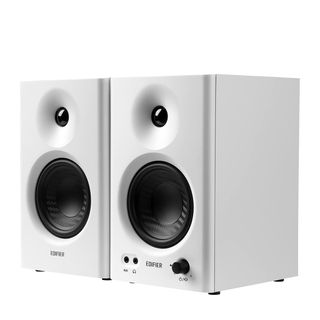
Best budget for creative work
For how much it costs, these studio monitors blows us away with its fantastic audio that's neutral enough for a podcast or mixing a song.
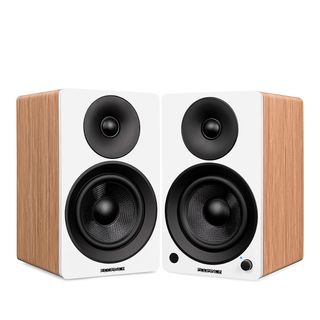
Best Bluetooth PC speakers for music
You’ll have a hard time finding a set of powered bookshelf speakers that sound as good as these, especially for music listening via Bluetooth.

Best for small spaces
For a pair of tiny bookshelf speakers that's also affordable, this set delivers surprisingly full, rich audio and several connectivity options.
The best computer speakers 2024
Why you can trust TechRadar
The best computer speakers overall

Specifications
Reasons to buy
Reasons to avoid
The Logitech Z407 offers great value in an affordable and appealing package. These minimalist, capsule-shaped speakers deliver great sound quality and a decent amount of volume while offering wireless connectivity, two physical input options, and a versatile design.
For your convenience, it comes with a control puck that connects wirelessly so you can change the volume, dial the bass power up/down, play/pause/stop the current content, and move forward or go back from up to 20 meters away. We found this dial a bit confusing to use at first, but it’s a nifty addition that adds convenience to its use.
That subwoofer is surprisingly powerful for its size as well, producing a good amount of rumble for those intense game and movie moments. If you think that computer speakers are becoming obsolete, these will certainly change your mind.
Read the full Logitech Z407 review
The best budget PC speakers
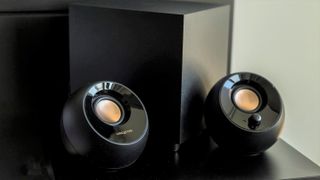
Specifications
Reasons to buy
Reasons to avoid
You don’t need to spend a fortune on a good set of computer speakers. For budget-conscious consumers, Creative’s Pebble Plus is more than good enough for the job, whether you’re a hardcore gamer or a film fanatic. This 2.1 speaker system may not be audiophile quality, but it produces great sound for how much it costs. In fact, you’d be hard-pressed to find better stereo sound at this price range.
Consisting of two far-field drivers angled at a 45-degrees and a down-firing subwoofer, the Pebble Plus delivers good highs, mids, and lows. Not only that, but we found during our tests that it also does a great job of minimizing distortion at loud volumes, which isn’t something you’ll often find on budget speakers.
There are some compromises here, as is expected on inexpensive peripherals, but none of those are too big to put you off. Hands down, these are the best computer speakers for those on a tight budget.
Read the full Creative Pebble Plus review
The best computer speakers for surround sound

Specifications
Reasons to buy
Reasons to avoid
Nothing can replace the experience of real surround sound. Turning on virtual surround sound for a pair of headphones or a set of speakers only approximates that fully immersive experience. And, there aren’t many computer speaker setups that will give you a true 360-degree audio experience.
Well, Steelseries has fixed that with their flagship speaker system, the Arena 9. Comprised of six separate speakers: two front satellites, a center channel speaker, two rear satellites, and a subwoofer, this 5.1 system will transport you, as it did us, into your favorite games and movies instantly.
We find that games especially come alive with the Arena 9s. Audio elements physically circle us when we move our character’s point of view. And, thanks to that subwoofer, we feel the rumble whenever there’s an explosion. Even when listening in stereo, the audio sounds detailed, clear, and engaging.
So, if you’re considering investing in surround sound, it’s hard to do better than the Arena 9 - just make sure you have the desk space for it.
Read our full SteelSeries Arena 9 review
The best premium with mind-blowing sub
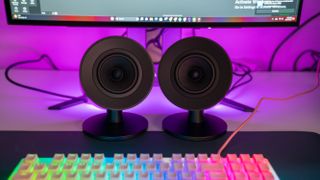
Specifications
Reasons to buy
Reasons to avoid
The long-awaited successor to Razer’s best computer speaker system is here, and it’s even better than its predecessor, which we honestly didn’t think was possible. The Razer Nommo V2 Pro is a much improved system inside and out, with a sleeker design that takes up less space, even though it’s not necessarily what you’d call compact, a now-wireless control puck, and better audio overall.
Its audio performance is where this 2.1 system really shines, giving us crisp and detailed highs as well as full and present mids during testing, and a whole lot of punchy bass and deep rumble that practically shook our reviewer’s apartment building. And while its soundstage proved to be reasonably wide and its sound imaging very good, switching to THX Spatial Audio made our gaming experience all the more immersive while keeping things natural-sounding.
You can’t take home this kind of speaker system without a price, however, and in the Razer Nommo V2 Pro’s case, it’s a pretty steep one. But, if you’re a more discerning listener, you’re getting your money’s worth here – that’s especially compared to true audiophile systems that are much more expensive.
Read our full Razer Nommo V2 Pro review
The best PC speakers for gamers on a budget
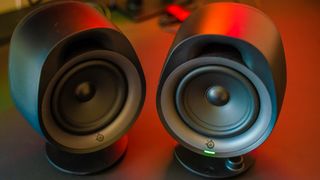
Specifications
Reasons to buy
Reasons to avoid
The Steelseries Arena 3 are the company’s entry-level speakers. As such, they’re the most stripped down of the company’s product line. And, while you won’t get the rear satellites of the Arena 9 or the subwoofer of the Arena 7, you’re still getting quality sound, an immersive soundstage, and entry into Steelseries’ new audio suite.
Listening to these speakers, we found them to have a solid mid-range and a wide soundstage. Of course, the bass doesn’t go too deep as these are on the smaller side and the high end is slightly veiled.
However, we found that we could play around with the sound quite a bit thanks to the Steelseries’ Sonar Audio Suite. Specifically, there’s a parametric EQ on hand that lets you fine-tune your audio far beyond what most gaming and computer-centric speakers allow. And, if you have a multiple-device setup, know that the Arena 3 comes with two analog inputs and a multi-function button that lets you switch between the two easily.
Read our full SteelSeries Arena 3 review
The best PC soundbar
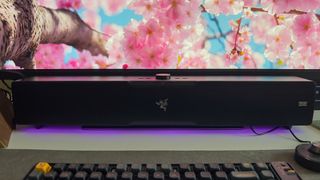
Specifications
Reasons to buy
Reasons to avoid
The Razer Leviathan V2 Pro is proof that you can get away with a space-saving setup and still have a truly immersive experience. This soundbar-sub combo is a fantastic audio solution if you want a 5.1 speaker system for your desk but don't necessarily have the space to accommodate that kind of setup.
Razer's brilliant plan here isn't just to put five drivers in a single - and relatively compact - soundbar, add a downward-firing sub, and let it all loose. This offering also comes with thoughtful features such as head-tracking AI, different audio modes, and customizable RGB lighting, all of which contribute to your audio immersion. And, it's more affordable than you might think.
Sure, it isn't perfect. During testing, we found that the high end lacking and the mids sometimes sounded a little muddy. However, it makes up for those with a powerful bass that can literally make a small room shake, great sound imaging, and a surprisingly wide soundstage. It's definitely one of our favorite computer speakers in 2024.
Read the full Razer Leviathan V2 Pro review
Great for everyday use and studio work
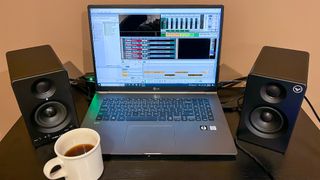
Specifications
Reasons to buy
Reasons to avoid
There are a few things that make the Vigilant Audio SwitchOne special. To start, they’re powerful and room-filling speakers that sound excellent despite the fact that there are just two small-ish bookshelf speakers and no subwoofer. And, yes, they come with impressive even without a sub.
They also come with “The Switch” that switches the SwitchOne from a more HiFi-sounding stereo speaker setup to one with a flatter, more neutral frequency response perfect for doing studio work. We were even able to use these monitors to mix when tested. Of course, we did find the switch in frequency responses to be on the subtle side.
Since they were meant for use with a computer, we did miss having USB connectivity but it has all the other types of connectivity you could need including Bluetooth. All in all, the Vigilant Audio SwitchOne is a fantastic option if you don’t need USB and can afford its slightly higher price tag.
Read our full Vigilant Audio SwitchOne review
The best budget speakers for content creation

Specifications
Reasons to buy
Reasons to avoid
When we first heard the Edifier MR4 studio speakers, we were blown away, especially considering its price tag. At any rate, these are mostly fantastic-sounding speakers that are close enough to neutral that you can use them for content creation, whether that’s fixing audio for a podcast or mixing a song.
Considering the low price, there has to be a catch. And, there are a few. Most importantly, the MR4’s low end was underwhelming whenever we used them at normal listening volumes, only filling in when turned up. Even then, you won’t be getting that sub-bass rumble when watching a movie or playing a game (and there’s no sub out either).
Its multiple analog inputs are great for use with a computer, audio interfaces, and external devices like a phone but there’s no Bluetooth or USB on hand. However, a quick listen to the MR4 studio monitors, not to mention a look at the price tag, will quickly make those concerns a non-factor.
Read the full Edifier MR4 review
The best Bluetooth computer speakers for music

Specifications
Reasons to buy
Reasons to avoid
The Fluance Ai41 comes with one major flaw, specifically that it doesn’t come with USB connectivity. But if you can get around that – after all, you do have Bluetooth, RCA, and optical input options – you’ll have a hard time finding a set of powered bookshelf speakers that sound as good as these.
We were surprised when testing how good they sound. The bass is particularly deep on these ported speakers. Almost to the point where we don’t miss having a subwoofer. And, the high-mids are only slightly boosted for a bright yet still rich audio quality.
While we did find it to take up a little more desk space than we would like, we still heartily recommend them. Of course, if you have an unusually cramped desk or are on a budget, you might have to look elsewhere. But those one-inch silk dome tweeters and five-inch woofers do sound glorious when you turn them up.
Read our full Fluance Ai41 review
The best computer speakers for small spaces
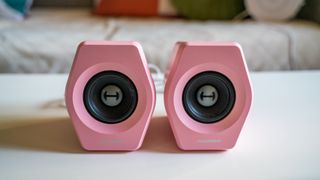
Specifications
Reasons to buy
Reasons to avoid
The Edifier G2000 may be among the tiniest computer speakers you'll ever see, but don't let that small footprint fool you. These popular offerings from Edifier are more potent than they look in terms of audio and punch above their weight in connectivity as well.
They may not look it, but we found the G2000 to deliver full, rich audio with fairly balanced mids and clear high-end. And, while they're not that great in sound imaging, they should deliver a wide soundstage as long as they're placed far enough apart. We also appreciate that you can not just connect to them via USB and 3.5mm, but Bluetooth as well.
Some might argue that these should be cheaper than they cost, but we do think you're getting a great value here. You're getting the perfect compact computer speakers for your small setup without compromising on sound quality, which is pretty great. Throw in the RGB lighting and the unique look, and it's the full package.
Read our full Edifier G2000 review
How to choose the best computer speakers for you
Choosing the best computer speakers is more complex than choosing the best laptop or desktop. While you can always go with something more expensive and hope that’s an indication of quality, there aren't clear-cut metrics or numbers to go on as there are with a computer.
There are still some objective considerations, however. Some speakers only connect through an analog 3.5mm connection, while others include USB, optical or Bluetooth connectivity. If you’re a stickler for audio fidelity, a digital connection like USB or optical is necessary for an uncompressed signal. If you care more about a minimalist setup, you should prioritize speakers with Bluetooth. Thankfully, Bluetooth has come a long way and plenty of Bluetooth speakers offer incredible sound. However, if your primary concern is budget, you’ll most likely end up with a set of speakers equipped with an analog connection.
You’ll also want to consider how important that low-end is for you. If you want something that can shake the walls whenever there’s an explosion in the game you’re playing or movie you’re watching, you’ll want a system with a subwoofer.
Consider the speakers' size as well, particularly if you have a small space, and other included features such as an included remote or control pod/puck to easily control the speakers.
The most important consideration, the sound quality, is also the most subjective. Do you prefer bass-heavy audio or want something a bit brighter? Everyone gravitates towards a different sound. You’ll have to consider if you want something with a lot of bass, a brighter sound or a more neutral frequency response.
Frequently asked questions on computer speakers
What are the features of a good computer speaker?
There are not necessarily any particular features that separate the best computer speakers from subpar ones. It's more a matter of execution. However, you’ll end up with better results if you get something with some kind of digital connectivity, whether that’s USB, Optical or even Bluetooth. Analog speakers can still sound great, but they tend to sound a little more compressed in comparison.
With that said, some computer speakers come with some quality of life features that make controlling them easier. A remote or control pod are a welcome addition so you can adjust the volume and possibly other parameters without having to minimize whatever you’re watching or playing.
Which brand speaker is best for PC?
There’s no king of the mountain when it comes to the best computer speakers. Plenty of brands offer quality options that will satisfy most people’s needs when it comes to listening to movies, music, or games. The best one for you will somewhat depend on what you spend most of your computer time doing.
However, you can count on most peripheral companies like Logitech, Creative and Razer to produce quality products. And, of course, audio-focused companies like Audio Engine and Harmon Kardon produce great speakers as well.
Where you can get into trouble with brands is when you’re trying to save money and go with something unknown such as a random manufacturer off of Amazon. While there may not be a best, it’s best to stick with brands that are recognizable and have a track record of making good quality speakers.
How do I set up my computer speakers?
Most computer speaker systems come with either 2 or 3 pieces. You’ll end up with a left speaker, a right speaker, and, in some instances, a subwoofer. Setting them up is typically fairly easy. But, you don’t want to just place each speaker on either side of your monitor or laptop. You’ll also want to angle them so that they’re pointing at where your head typically is when you’re sitting at your computer. You’ll notice that some computer speakers are even angled to help with this. You can also move the speakers further out to widen the sound stage if you want to feel a little more immersed. Just make sure to keep them around a few feet away.
Subwoofers are meant to go on the floor. Not only are a good number of them downward-firing, meaning the sound is supposed to bounce off the floor before it gets to you, but they tend to move more air than regular speakers. So, if you’re keeping your subwoofer on your desk, you might end up dealing with a lot of unnecessary vibrations. Just keep the subwoofer somewhat close to your desk, whether it’s directly underneath or off to the side.
Lastly, there are a few soundbars marketed towards computer use. If you’ve bought one of those, just make sure that it’s centered with you so that you get the most of its most likely limited sound stage.
How we tested these computer speakers
When we test a pair of computer speakers, we spend hours listening to various media. We use it for audio to watch blockbuster movies and the latest shows on Netflix, listen to multiple genres of music, and play an assortment of computer games.
During our listening sessions, we focus on how well the low-end, midrange and high-end frequencies are represented and how it all affects the speakers' frequency response. Some speakers might have too much high-end, making for an overly bright and unpleasant listening experience. Sometimes, there’s too much low-end, resulting in muddy-sounding audio.
We spend a lot of time living with the speakers, getting a sense of how they sound, if they're appropriate for certain applications and, subjectively, making a judgment call on the audio quality.
Beyond the sound quality, we take into account the different connectivity options and how that impacts what we hear. We compare the sound quality between the different connections and whether the end result has the same audio quality or not.
We consider the build quality as well. We inspect speakers that we test to see what they’re made of and whether the parts look to be made of tougher or cheaper material.
Any extra features are thoroughly tested. If a speaker system comes with a subwoofer, we see how much control we have over it, how loud it can get in comparison to the speakers and how well it mixes with the speakers. Remotes and control pods, also sometimes referred to as pucks, are tested to make sure they work as advertised. And, if there’s any RGB lighting, we take a look at that as well.
Lastly, we take all of that and weigh it against the asking price to see if it’s offering a good amount of value or whether it’s worth its accompanying price tag.
Today's best computer speaker deals
Get daily insight, inspiration and deals in your inbox
Get the hottest deals available in your inbox plus news, reviews, opinion, analysis and more from the TechRadar team.

Michelle Rae Uy is the former Computing Reviews and Buying Guides Editor at TechRadar. She's a Los Angeles-based tech, travel and lifestyle writer covering a wide range of topics, from computing to the latest in green commutes to the best hiking trails. She's an ambivert who enjoys communing with nature and traveling for months at a time just as much as watching movies and playing sim games at home. That also means that she has a lot more avenues to explore in terms of understanding how tech can improve the different aspects of our lives.
- Christian GuytonEditor, Computing
